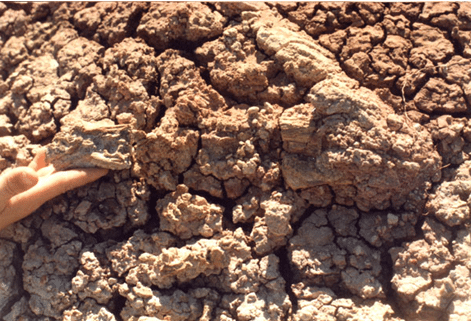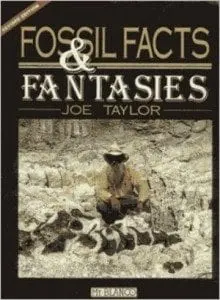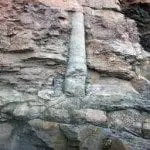By Joe Taylor, Paleontologist @ Mt. Blanco Fossil Museum in Crosbyton, Texas.
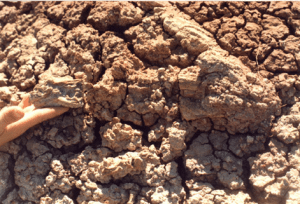
How art thou, dead bones, once white, now filled with mineral color? From bone to stone you are turned! So like the Spirit of God who invades dead men’s hearts turning them from stone to flesh and life!
One of the great questions of fossil work is, “Why are bones turned to stone, and that of every color, even clear?!” In the Triassic Red Beds where I have spent 30 years collecting, one will find a hill of tan clay, with bones of a yellowish tan color, bearing creamy tan roots of their once white enameled teeth, now a shiny brown. On the next eroded bank there are deep blue and deep red bones, and just around the bend a deposit of pinkish clay cradles bones of baby blue.

From the gentle slope of a nearby creek bank, gray bones come from a cache of the mixed bones of the oddly named Phytosaurs — plant lizards — the long-snouted crocodiles, huge salamanders up to twelve feet long, and giant armored crocodilians with five sets of horns on their necks. The snout of one giant, fifty foot long croc has eroded out and broken, revealing a look inside the nerve canals -which are white and covered with dense complex brown bone, with patches of bright orange, red and black; one dark brown jaw tooth erodes out a few feet away that is an inch and a half wide, as wide as those in the largest T-rex!
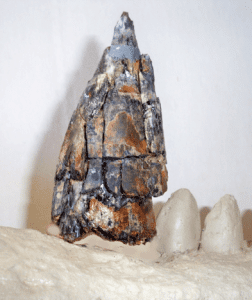
One of the armored bony plates covering the huge croc’s back has been exposed by recent rains. It is as large as a dessert plate, and jet black! On the surface in a nearby pasture, the vertebra of a long dead member of these ancient swamps lies in two pieces, with deep puncture marks made by a Phytosaur some 25 feet long. Not far away are two Phytosaur teeth. They have light tan roots with jet black enamel. This is odd. Most of the teeth here are shiny brown. However, there are also purple-brown teeth, and even white. The back of a skull of a small Phytosaur crocodile is sticking up through the grass. It is black, and some excavation uncovers the lower jaw still intact, with glassy-smooth jet black teeth with roots the same color.
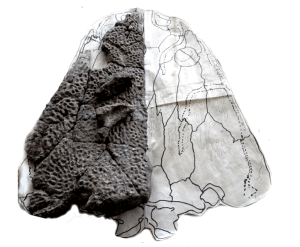
Within teen feet of this ten foot long Phytosaur is a hill of purple red, giving up the large, dark red horns of an Aetosaur, the armored crocodilian found here. Fifteen feet away is a Metoposaur skull, the giant salamander. The bones are jet black, and mostly lying on the surface. While restoring it, I found that a large crocodile had bitten through the back of its head, probably killing it instantly, as the teeth went right into their walnut-sized brain. Twenty feet from these black and red bones were another set of Aetosaur horns, this time yellow brown. But we’re not through with the color wheel yet; 20 feet from it are the blue horns of another Aetosaur!
Along the edge of a dry wash, a layer of brown sandstone caps the falling layers of clay underneath it. They are bluish gray and purple. Not far below the sandstone were parts of the long, narrow armor plates once covering another Aetosaur — to my astonishment they were almost clear!!
A thin layer of coarse gray sandstone yielded the skulls of two juvenile giant salamanders, colored China white. A slightly different sand stone produced a cream colored skull of the same.
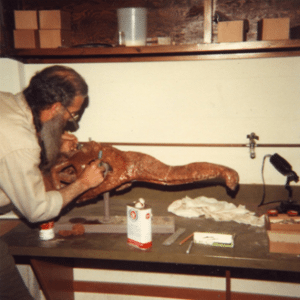
The roots of ancient cypress trees are mingled with all these swamp dwellers, but some limbs are petrified on one end and coalified on the other. Some of these petrified trees have cloudy yellow crystals inside. Others are tan, while some are jet black. From the purple red clay layers will come the most beautiful mauve bone, smooth as it was in life, and not fifty feet away the horns of an Aetosaur are almost white. Green, brown, and hot pink are other colors these bones have taken on.
That in itself is amazing, and I have said nothing of the complexity of these bones’ structure. What can be seen with the naked eye are layers of bone weaving across themselves in a web so complex as to defy any idea of random chance evolution! And this is not even under a classroom microscope. I found one tiny, pure white, hard enamel object only a quarter inch across. Under a simple microscope it was amazing to see a perfectly round bump surrounded by a series of a dozen or more tiny white bumps. I asked the expert Triassic paleontologist, Dr. Sankar Chatterjee, about it. It was a tooth plate of a fish! Incredible? Yes! Another fish found there had teeth that look like a triangular section of a corrugated metal roof.
What happened? How could these white bones and teeth all become these colors of stone? One can say that as the bones became water-logged and lost their fat, the minerals in the swamp mud slowly replaced the very complex cell structure of the original bone, but why? And why so many colors from an area only fifty feet square? For one, they all had to be buried immediately in the mud of the swamps they lived in, or they would have ended up like crocodile bones in the swamps of today – disappeared! The only event that could have buried all the vast swamps that dotted the world was the great worldwide flood of Noah. It’s miraculous.
Don’t anybody tell me this just all happened. It was designed by an all Powerful God, our Lord and Savior, Jesus Christ Who made all things and there was not anything made that was not made by Him.
Joe Taylor is the owner and curator of the Mt. Blanco Fossil Museum and associated companies. As a young man he left the area for art school and a career in commercial illustration and advertising design in New York City and Los Angeles. During this time he volunteered at the La Brea Tar Pits in Los Angeles, California where the saber tooth cat skull which he reproduces is from. His interest was sparked by the rich local fossil deposits and a desire to find out the truth about fossils. The results of this interest are seen in the museum. Mr. Taylor is one of the nation’s foremost fossil restorationists, and his work is sought out by individuals, museums, and other institutions in this country and abroad.
Read more about Joe Taylor’s fossil findings in his book, HERE:
Get your copy of Fossil Facts and Fantasies in the Creation Superstore!
“Fossil Facts and Fantasies” is personally based on years of eyewitness research, study and excavation of fossils from many parts of the United States and elsewhere. It dispels the myth of evolution and shows demonstrable evidence for creation. It has been said that “a picture is worth a thousand words”. This book contains over 300 photographs and drawings displaying the evidence for the Biblical account of creation.

